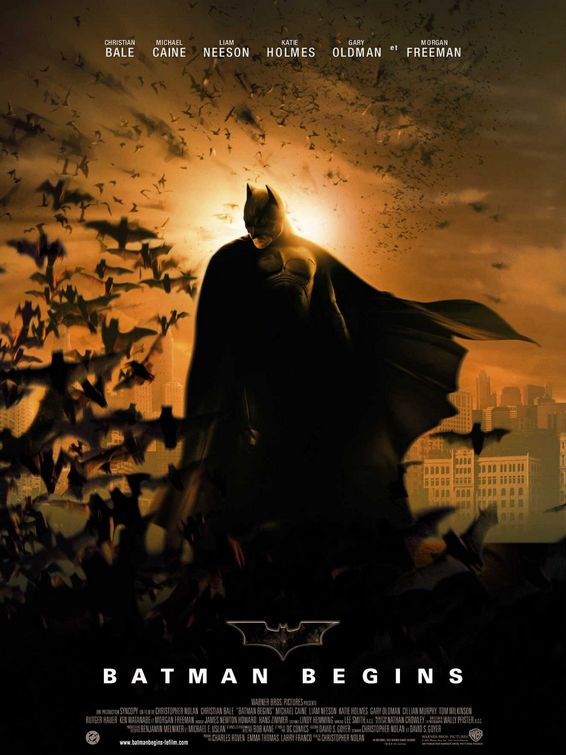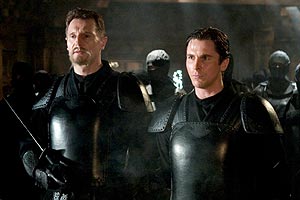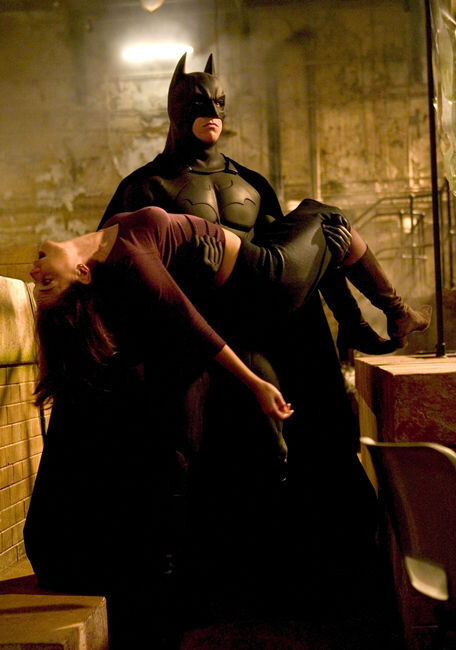
This post is a story and theme analysis of Batman Begins, as an appetizer for the ethical review of The Dark Knight coming in 3 days. Thanks to Ryan Blue, an accomplished story analyst and teacher. Check out his blog on the elements of story at lifeofmystory.blogspot.com.
Batman Begins and The Dark Knight could easily be one continuous movie. Batman Begins defines Batman and his values while The Dark Knight puts those values to the test. Think of Batman Begins as the classroom and The Dark Knight as the lab where things literally get blown up.
Batman Begins reveals how, and more importantly why, Bruce Wayne (Christian Bale) became Batman. The why behind the creation of Batman's persona is really the focus. The themes presented are the different lessons he has to learn which will serve as his reasons and means for fighting injustice.
 First, Bruce has to learn the difference between justice and revenge. On the one hand, Henri Ducard (Liam Neeson) tells Bruce that justice is balance: an eye-for-eye and tooth-for-tooth. Ducard burns down Wayne Manor because Bruce had burned down Ducard’s house. “Consider us even,” says Ducard. According to Ducard, justice and revenge are one and the same. On the other hand, Bruce's girlfriend, Rachel Dawes (Katie Holmes), responds very pointedly to Bruce when he says he wanted to kill the man who murdered his parents because they deserved justice. Rachel says that there is a difference between justice and revenge: “Justice is about harmony,” whereas “revenge is about making yourself feel better.” In the end, Bruce rejects Ducard’s definition of justice and tells Rachel she was right: “Justice is about more than revenge."
First, Bruce has to learn the difference between justice and revenge. On the one hand, Henri Ducard (Liam Neeson) tells Bruce that justice is balance: an eye-for-eye and tooth-for-tooth. Ducard burns down Wayne Manor because Bruce had burned down Ducard’s house. “Consider us even,” says Ducard. According to Ducard, justice and revenge are one and the same. On the other hand, Bruce's girlfriend, Rachel Dawes (Katie Holmes), responds very pointedly to Bruce when he says he wanted to kill the man who murdered his parents because they deserved justice. Rachel says that there is a difference between justice and revenge: “Justice is about harmony,” whereas “revenge is about making yourself feel better.” In the end, Bruce rejects Ducard’s definition of justice and tells Rachel she was right: “Justice is about more than revenge." Next, Bruce Wayne must learn how to handle fear; he must overcome his fear of criminals, those who use fear as a weapon. Mafia don Carmone Falconi (Tom Wilkinson) says that the power of fear is the kind of power money can’t buy. Twice Bruce tells Falconi he is not afraid of him. Falconi tells Bruce he doesn’t understand the criminal world and “you always fear what you don’t understand.” So Bruce goes 1,000 miles away where nobody knows his name and lives as a criminal in order to better understand that world so that he won’t be afraid of it. Additionally, Ducard plans on using fear as a weapon to destroy Gotham. He plans to disperse a weaponized hallucionogenic which will strike fear into people so they kill each other.
Next, Bruce Wayne must learn how to handle fear; he must overcome his fear of criminals, those who use fear as a weapon. Mafia don Carmone Falconi (Tom Wilkinson) says that the power of fear is the kind of power money can’t buy. Twice Bruce tells Falconi he is not afraid of him. Falconi tells Bruce he doesn’t understand the criminal world and “you always fear what you don’t understand.” So Bruce goes 1,000 miles away where nobody knows his name and lives as a criminal in order to better understand that world so that he won’t be afraid of it. Additionally, Ducard plans on using fear as a weapon to destroy Gotham. He plans to disperse a weaponized hallucionogenic which will strike fear into people so they kill each other.More importantly, Bruce must overcome his own trepidation. He tells Ducard he wants to turn fear on those who prey on the fearful. Ducard however tells him that in order to manipulate the fears of others you must first master your own fears. Ducard asks Bruce what it is that frightens him. Flashing back on a childhood encounter with bats, it is evident that Bruce is afraid of being afraid. The bats are simply the visible expression of his terror. This is why Thomas Wayne’s dying words to his son were to not be afraid. Later, Bruce tells his butler Alfred (Michael Cain) he is choosing to become a "batman" because he is afraid of bats and it’s time for his enemies to share his dread. So bats represent fear and he will use this imagery to strike alarm and gain advantage over his enemy.
Ducard tells Bruce you must become what you fear in order to overcome it, primarily why Bruce became a criminal. Now he must become fear in order to overcome fear. Ducard tells Bruce that people fear most what they cannot see. So Bruce battles Ducard while Ducard is blending in with other warriors. Bruce cannot see him. Bruce turns the tables on Ducard by blending in with the warriors so that Ducard can’t see him. It's a power play to defeat him. At this point Ducard acknowledges Bruce has purged his fears. He is "fearless."
Bats are the visible expression of Bruce’s fear of fear; they also serve to chronicle his journey in overcoming his apprehension. First, bats attack Bruce as a kid and we see him afraid, lying flat on the ground. Second, we see bats fly out of the box at Ducard’s fortress and Bruce falls partly backwards. Clearly he is not as fearful as when he was a kid. Third, we see Bruce stand completely upright as bats swarm in the cave, an indication he has overcome his fear. Finally, we see Batman use bats under his control to attack the police who fall down in fear. This allows him to escape. He can now control fear. In fact, the whole persona of Batman is intended to strike fear into the minds of criminals because men fear what they can’t see. Batman often lurks in the shadows before he attacks in order to create fear in the mind of his opponent. Indeed, one of the messages of Batman Begins is President Roosevelt's famous phrase, repeated by drug-dealer Dr. Crane: “The only thing we have to fear is fear itself.”
 The next lesson Bruce Wayne must learn is the proper means of administering justice. Ducard presents a murderer to Bruce, saying he deserves to die. According to Ducard, only the administration of the death penalty will prove Bruce’s commitment to justice. He must be willing to do whatever is necessary, be willing to kill. The only issue is whether the person is willing to act. Ducard tells Bruce his dad died because he wasn’t willing to kill his attacker. Bruce however is no executioner. He refuses to be the one who deals punishment. He defers to the proper officials, always leaving criminals for the police to find. Thus, he refuses to kill the man accused of murder. In fact, Batman is known for his unwillingness to intentionally kill. Ducard sees this as compassion, which is a weakness he says, “your enemies won’t share.” Ducard believes that there are those without decency who must be fought without hesitation and without pity. However, Bruce sees this ‘compassion’ as the one thing that separates him from the criminals. At the climax of the movie, Ducard asks Bruce if he had finally learned to do what is necessary, the will to kill. But Batman responds that while he won’t kill Ducard he doesn’t have to save him either. It is this ‘one rule’ of Batman’s that will be put to the ultimate test by the Joker in The Dark Knight.
The next lesson Bruce Wayne must learn is the proper means of administering justice. Ducard presents a murderer to Bruce, saying he deserves to die. According to Ducard, only the administration of the death penalty will prove Bruce’s commitment to justice. He must be willing to do whatever is necessary, be willing to kill. The only issue is whether the person is willing to act. Ducard tells Bruce his dad died because he wasn’t willing to kill his attacker. Bruce however is no executioner. He refuses to be the one who deals punishment. He defers to the proper officials, always leaving criminals for the police to find. Thus, he refuses to kill the man accused of murder. In fact, Batman is known for his unwillingness to intentionally kill. Ducard sees this as compassion, which is a weakness he says, “your enemies won’t share.” Ducard believes that there are those without decency who must be fought without hesitation and without pity. However, Bruce sees this ‘compassion’ as the one thing that separates him from the criminals. At the climax of the movie, Ducard asks Bruce if he had finally learned to do what is necessary, the will to kill. But Batman responds that while he won’t kill Ducard he doesn’t have to save him either. It is this ‘one rule’ of Batman’s that will be put to the ultimate test by the Joker in The Dark Knight.Copyright ©2008, Ryan Blue

great post
ReplyDelete